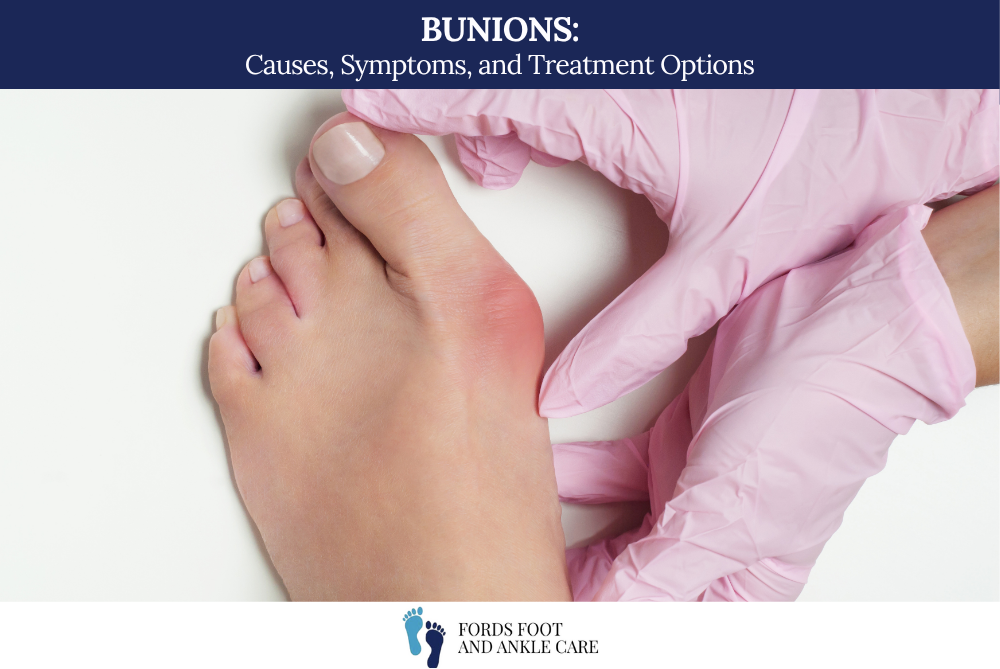
By Fords Foot and Ankle Care
Bunions are a common but often misunderstood foot condition that can significantly impact your mobility and quality of life. At Fords Foot and Ankle Care, we specialize in diagnosing and treating bunions to help you walk comfortably again. If you’ve noticed a painful bump near your big toe joint or are experiencing discomfort while walking or wearing shoes, it may be time to explore your treatment options.
What Is a Bunion?
A bunion, medically known as hallux valgus, is a bony bump that forms at the base of the big toe joint. Over time, the big toe pushes against the second toe, causing the joint to protrude outward and become misaligned. This can lead to inflammation, pain, and difficulty fitting into shoes.
Common Causes of Bunions
Bunions develop for several reasons, including:
- Genetics – A family history of bunions increases your risk.
- Improper footwear – Tight, narrow, or high-heeled shoes can worsen bunion formation.
- Flat feet or overpronation – These structural issues place uneven pressure on the foot.
- Arthritis – Inflammatory conditions like rheumatoid arthritis can contribute to joint deformity.
Signs and Symptoms
Bunion symptoms may include:
- A visible bump on the side of the foot at the base of the big toe
- Swelling, redness, or soreness around the joint
- Corns or calluses where toes overlap
- Pain when walking or wearing shoes
- Restricted movement of the big toe
Bunion Treatment Options
At Fords Foot and Ankle Care, we offer both non-surgical and surgical treatment options tailored to your specific condition:
Conservative (Non-Surgical) Treatments:
- Padding and taping to relieve pressure and realign the toe
- Orthotic inserts to improve foot mechanics and reduce discomfort
- Anti-inflammatory medications or cortisone injections to reduce pain
- Footwear recommendations to improve fit and function
Surgical Treatments:
If conservative methods fail to relieve pain or the bunion continues to progress, we may recommend bunion surgery (bunionectomy). This outpatient procedure realigns the bone, ligaments, and tendons to restore the natural position of the toe.
Frequently Asked Questions (FAQs)
Q: Are bunions always painful?
A: Not always. Some people have visible bunions without pain, while others may experience significant discomfort. Pain often worsens with activity or improper footwear.
Q: Can bunions go away on their own?
A: No. Bunions are progressive and typically worsen without intervention. Early treatment can slow progression and relieve symptoms.
Q: Is surgery the only way to fix a bunion?
A: Surgery is the only way to permanently correct the deformity, but many patients find relief through conservative measures, especially in early stages.
Q: How long is recovery after bunion surgery?
A: Recovery varies by procedure, but most patients can expect 6–12 weeks before returning to regular activity. Full healing may take several months.
Q: Can bunions return after surgery?
A: It’s rare but possible. Wearing supportive footwear, using orthotics, and following your podiatrist’s recommendations can help prevent recurrence.
Q: Will bunion surgery leave a scar?
A: Yes, but most surgical scars fade significantly over time and are often small and discreet.
Why Choose Fords Foot and Ankle Care?
Our expert podiatric team uses advanced diagnostic tools and a patient-first approach to develop personalized treatment plans for bunion relief. Whether you’re looking to avoid surgery or seeking expert care for a complex case, we’re here to help.
Contact Us
Fords Foot and Ankle Care
📍 519 New Brunswick Ave, Fords, NJ, 08863
📞 Phone: (732) 738-4441
🌐 Website: fordsfootandanklecare.com
Let us help you take the next step toward pain-free feet. Schedule your appointment today and discover how our team can restore your comfort and mobility.
Your feet shouldn’t hurt. At Fords Foot and Ankle Care, we provide the care and expertise you need to put bunion pain behind you.
